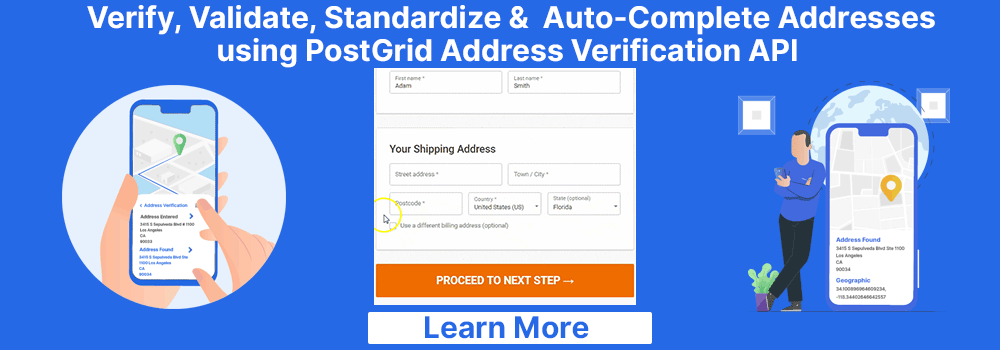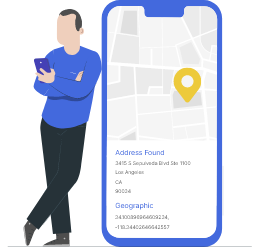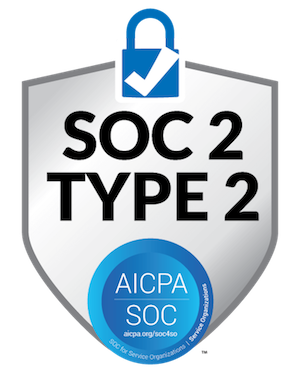
PHLPost Address Validation: How Does It Work and What Are Its Alternatives?
“PHL,” or Phillippine’s national postal system, was established in Manila in 1769. With over 250 years of history, the postal service covers the entire Philippine archipelago. It is the leading courier service in the Phillippines regarding the number of outlets and branches. But how do they ensure deliverability in complex regions? How do businesses operating in the Phillippines avoid misdelivery, delays, and return mail?
PHLPost solves these problems by providing a postal ID to verify postal addresses against official records. It is designed to help government agencies, ecommerce companies, and other private companies improve mail deliverability, marketing campaigns, and location intelligence efforts. How does it work? Can businesses solely rely on this service to validate their customer addresses before dispatching mail items? This blog will provide complete insights into how PHLPost address validation works, a better alternative, and the Filipino postal address format.

Key Takeaways
- PHLPost relies on Postal IDs to verify postal addresses against official records.
- PHLPost address validation aims to improve deliverability and reduce delays and failures.
- Businesses can use PHLPost’s Postal ID Online Verification System to validate addresses.
- PHLPost’s address validation method can only cover addresses of Postal ID holders.
- Individuals and businesses can use the PHLPost mail item tracking tool to find the last known status and location.
- The Philippines postal address system could be complex, having street names with multiple names.
- Filipino addresses heavily rely on Barangays as the most minor administrative division in the country.
- There’s no real-time validation, standardization, or auto-complete when you use PHLPost’s address validation tools.
- Businesses can validate high-volume addresses to save time and effort with PHLPost.
What is PHL Post Address Validation?
It refers to validating Filipino addresses against the official database of PHLPost, ensuring their existence and deliverability. PHL Post address validation aims to help businesses streamline their shipments and reduce delays and failures.
The Philippine Postal Corporation (PHLPost) provides an address verification tool that helps you ensure customers use a valid address for their orders, increasing customer satisfaction for retail and ecommerce businesses. Businesses need to use PHL Post’s Postal ID Online Verification System (POVS) to confirm the authenticity of customers’ postal IDs. However, the customers must submit the necessary documents to PHLPost to ensure their letters and parcels are delivered correctly. However, PHLPost address validation is highly dependent on Postal IDs.
What is PHL Post Postal ID?
The Phillippine Postal Corporation (PHLPost) has recently launched the Postal ID as an official method to verify addresses and identities for customers and ecommerce businesses. The high convenience and accessibility make it a fantastic choice for Filipinos, including foreign residents. A Postal ID issued by PHLPost is a reference for an individual’s identity and address. It contains crucial details that ensure proper, timely, and accurate delivery of mail items. Each postal ID is valid for three years from issuance and is non-transferable. The official nature of this document makes it a reliable source of address validation information.
However, the application process requires applicants to fill out the postal ID application form, attach the required IDs, and visit the nearest Post Office. After processing their information, the postal ID card is delivered to the recipient’s mailing address. It automatically verifies the cardholder’s address, helping businesses in their Know Your Customer efforts.
Which Documents Can Be Used as Proof of Identity?
- National ID
- Birth Certificate from PSA
- SSS UMID Card
- Driver’s License
- Passport
- GSIS UMID Card
- Marriage Certificate for Married Women
Government agencies and private companies can partner with PHL’s Postal ID to use the Online Verification System (POVS). This system features a web portal that helps confirm the authenticity of a postal ID by validating its identity and address information.
How Does PHL Post Address Validation Work?
Using Postal ID
Businesses can use PHLPost’s Postal ID Online Verification System to verify that the address matches PHLPost records. This ID serves as a government-issued ID with verified address information. However, you must ask your customers to provide their Postal ID upon delivery to ensure the mail item reaches the intended recipient. Businesses also need to request PHLPost to give access to their online verification system, which might take some time and involve multiple steps.
Mail Item Tracking
Users can use PHLPost’s online mail tracker tool to check their mail items’ last-known status and location. To use this tool, they should visit the company’s website, enter the unique tracking number, and click ‘Track.’ This tool lets you track up to 30 tracking numbers simultaneously, providing a convenient option for businesses.
ZIP Code Finder
Individuals and businesses can use PHLPost’s ZIP Code Finder tool to fetch the precise postal code of their address. It filters ZIP codes by separating them depending on their region, province, and city/municipality. You can use the search box to find the ZIP code for your city, locality, province, or region.
Post Office Finder
Individuals and businesses looking for the nearest post office should use PHLPost’s Post Office finder. Using this tool, you can also see their names, provinces, and complete addresses. The search box helps you instantly find a Post Office instead of browsing multiple pages.
Why are you Unable to Deliver Mail to a Filipino Address?
Invalid or Incomplete Address on the Label
Anyone can make mistakes while writing Filipino addresses. You might write the incorrect house number, street name, Barangay, or city. Postal workers can have difficulty delivering your mail items if you make mistakes in these address elements. It is advisable to use PHLPost address validation to verify the identity and address of your recipient. Negligence in validation might lead to delays, return mail, failures, or even lost packages.
No Consistency or Standardization in the Address
Filipino addresses use an officially accepted format, starting with the recipient’s name, house number, street name, subdivision, barangay, city or municipality, and postal code with the province name. You must follow this standard format when writing addresses in the Philippines.
Sadly, following these guidelines is difficult because some streets have multiple names, residents might only use the barangay name instead of the complete address, and people still use landmarks in rural areas. International businesses operating in the Philippines often face these standardization issues when sending mail to the country.
Invalid ZIP Code
An incorrect ZIP code on the address label of a mail item can lead to delays or misdelivery. Filipino addresses use a four-digit postal code system, with a ZIP code assigned to each city, town, or barangay. Any mistakes in writing the ZIP code might send your mail or package to an entirely different location.
The Recipient Was Absent at the Delivery Point
Your recipient might be absent at their address while the postal workers reach them with a mail item. PHLPost might leave a notice to inform the recipient to pick up the mail from the post office or try to reattempt the delivery. However, it could also be a sign of outdated address information. The recipient might have moved to another location, but you still have their old address. Filipinos must register a change of address request to receive their mail items at their new address. However, this process takes some time and involves bureaucracy.
Addressing Tips for Sending Envelopes and Parcels to the Philippines
- Abbreviations: PHLPost uses multiple abbreviations for different address-related terminologies. For example, Av. for Avenue, Brgy. for Barangay, P.O. Box for Post Office Box, No. for Number.
- Alignment: Filipino addresses are always left-aligned for ease of reading and postal processing.
- Language: People use Filipino and English as the official languages to write mail in the Phillippines.
- Postal Codes: The Philippines uses a shorter four-digit postal code system to help postal workers sort and route mail, parcels, and deliveries.
- Barangays: The Philippines relies on barangays as the country’s most minor administrative division. They function as the basic political unit for local governance.
PHL Post Address Format
Filipino addresses are very similar to Western addresses. You begin by writing the recipient’s full name. Next, you must include the house number, street name, and subdivision. Writing these three elements in this order, with commas separating individual units, is critical. Then, mention the Barangay followed by a comma and write the city or municipality name. The following line is meant to include the postal code and province name. However, there won’t be any punctuation between the two items. Lastly, you should write PHL in capital letters for the country’s name (Philippines) for international mail.
Here is what the format should look like:
| Recipient Name House Number, Street Name, Subdivision Barangay, City, or Municipality Postal Code and Province Name Country |
Your sample address would look like this:
| Juan Dela Cruz
1234 Mango Street, Sunnyvale Subdivision Barangay San Isidro, Quezon City 1100, Metro Manila Philippines |
PHL Post Address Validation Limitations
Limited Coverage of Filipino Postal Addresses
Although PHLPost address validation via Postal IDs provides a robust way to verify identities and addresses, it can only fetch address information linked to postal IDs. You may be unable to find residential and commercial addresses in its system. Businesses cannot confirm the authenticity of these addresses by relying only on Postal ID information, leaving the scope of misdelivery, delays, or return mail.
High Dependence on Postal IDs
Most countries host their official address databases for address validation. However, the Philippines’ address validation solution relies on Postal IDs. Because this is a relatively new system, some Filipinos still don’t have a Postal ID, making it almost invisible to address validation methods. Many businesses cannot verify customers’ postal addresses without a postal ID.
Lack of Real-Time Address Validation
PHLPost’s address validation method relies on the number of registrations they get for Postal ID. It stores information about an individual’s identity and address in a new database. Businesses using this tool cannot expect real-time address validation results to ensure the highest accuracy.
Manual Address Input
PHLPost provides a mobile application for individuals and businesses to verify Postal IDs. The application can scan the card’s QR code or require users to input the full address for verification. These time-consuming and manual processes are unsuitable for business applications requiring high-volume validation.
Absence of Geocoding Data
Most businesses rely on geographical coordinates to pinpoint their customers on the map for the most accurate address validation. Sadly, PHLPost address validation only provides insights about an individual’s identity and address. You don’t get latitude and longitude information for location intelligence or precise validation.
No Integrations to Support Bulk Validation Workflows
PHLPost only provides a mobile application to verify Postal IDs and check the authenticity of postal addresses. You won’t find API integrations with your favorite tools to run bulk validation workflows. Companies with large-scale verification jobs cannot utilize PHLPost address validation to ensure deliverability, location intelligence, and accuracy.
Business Challenges With the PHLPost Address Validation System
Fake Addresses
Some people use fake or borrowed utility bills to give a false address. They do this for crimes like identity theft, money scams, or illegal sign-ups. It is fairly difficult to spot these fraudulent addresses by relying only on the Postal ID database.
Rural and Informal Settlements Without Formal Addresses
Many people in rural areas or informal settlements do not have house numbers or street names. This makes traditional verification very hard. Besides, the lack of geographical coordinates makes it even more challenging to locate addresses in rural areas.
Higher Onboarding Friction
The customer onboarding process requires thorough verification of postal addresses. Businesses can have a hard time with the PHLPost address verification system. They have to do it one by one since the tool doesn’t offer any scope for scalability to verify high-volume addresses.
Limited Use Cases
The PHLPost address validation system is only suitable for mail and ecommerce applications. You cannot do anything advanced like location intelligence, customer verification, route planning, census, etc.
Increased Shipping Costs
Businesses lose money when addresses are wrong. Bad address data increases shipping costs. If you ship products or services, correct addresses are vital for on-time delivery. Wrong or incomplete addresses cause delays and higher costs. The absence of premise-level data and geocoding data with the PHL address verification system can be the reason behind all these issues.
Best Practices to Improve the Philippines' Address Data Quality
Build a Robust Data Quality Framework
Managing address data needs a clear, detailed plan. This plan must explain every step of handling the data. It should cover tasks like checking and improving the data. Clear rules help organizations keep data accurate and reduce mistakes.
Use Automation Technology
Using new technology is key to improving address accuracy and consistency. Advanced tools can check addresses automatically. This reduces manual work and human mistakes. These tools compare address data with trusted databases. Besides, they quickly find and fix any errors.
Incubate a Culture of Data Quality Awareness
Building a culture of good data quality is important. Leaders must show why accurate data matters for the company’s success. They should set a clear example for everyone. This approach helps all employees focus on data quality in their daily work.
PHL Post Address Validation Alternative
As mentioned, PHLPost address validation relies on the Postal ID to fetch address information. Businesses don’t get a comprehensive validation solution to verify, standardize, cleanse, or autocomplete customer addresses. The Postal ID might be a revolutionary initiative by the Philippines Post, but it is still in its infancy and depends on how quickly people enroll. Businesses shipping mail to the Philippines should find a better alternative to ensure higher deliverability, customer satisfaction, and low wastage.
PostGrid’s address validation API is a comprehensive solution for validating, standardizing, auto-completing, and cleansing address data from multiple authoritative and credible sources. Our solution can validate 200 K addresses simultaneously, so you won’t need to worry about high-volume address data. The zero-code integration integrates the solution with your website, mobile application, or CRM system for instant, real-time validation at your fingertips. You won’t even need to type the complete addresses; the autocomplete feature provides up to 100 suggestions, saving time and effort.
Businesses can use PostGrid as a better alternative to PHLPost address validation. It gives you geocoding information and premise-level address validation results. Companies of any scale and budget can use our solution to save time and ensure accuracy.
PHL Post vs PostGrid Address Validation: Which is Superior?
| Criteria | PHLPost | PostGrid |
| Real-Time Validation | PHLPost relies on its Postal ID database to fetch results for address validation jobs. | PostGrid uses multiple authoritative databases to provide real-time address validation. |
| Scalability | PHLPost doesn’t provide any scope for scalability to validate high-volume addresses. | Businesses can simultaneously upload CSV or XLS files to validate up to 250,000 addresses. |
| Address Autocomplete | Users must type the complete address manually to verify its authenticity and deliverability. | Our solution can produce up to 100 results for each input, saving time and effort for the user. |
| Geocoding Data | You don’t get any geographical coordinates for addresses when using PHLPost address validation. | We fetch Filipino addresses’ precise geocoordinates (longitude and latitude data) for enhanced validation. |
| Premise Level Data | It doesn’t provide any premise-level data for individual units to support address validation. | PostGrid helps you fetch secondary address indicators like floor, unit, building, and suites, enriching results. |
| Coverage | PHLPost’s coverage is highly limited to Postal ID holders in the Philippines. | PostGrid’s solution covers 245+ countries and territories. |
| Cost | PHLPost address validation might be more affordable but requires intensive manual processing. | PostGrid provides flexible plans and even a pay-as-you-go model for businesses of any scale. |
| Use Cases | The address validation is only suitable for mail and ecommerce applications. | PostGrid’s solution can have broader applications, including mail delivery, location intelligence, route optimization, etc. |



 Also Read:
Also Read: 






